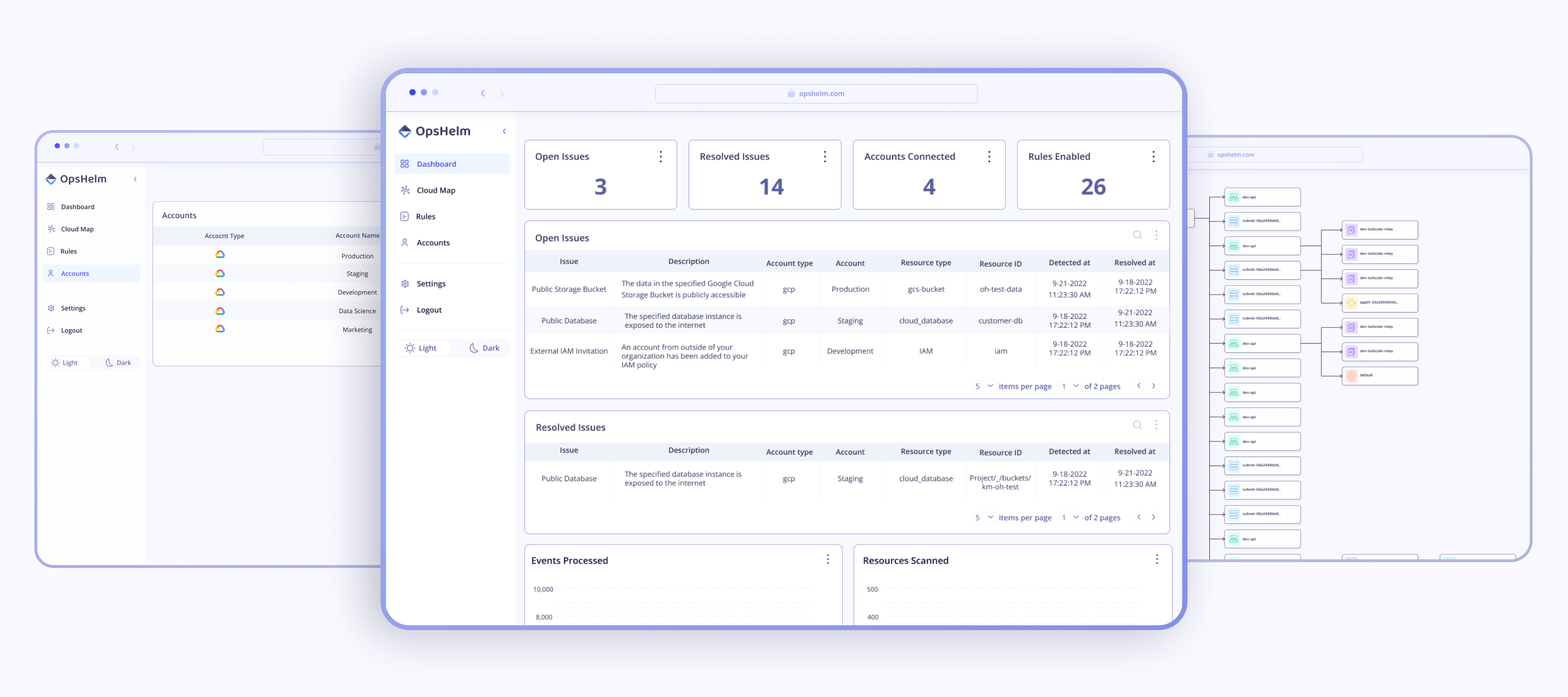Announcing OpsHelm

What a year.
Today, I’m excited to say that we’re officially coming out of stealth and introducing OpsHelm to the world. OpsHelm is a lightweight solution designed to identify and proactively fix cloud environment misconfigurations. It takes the labor-intensive development work required to secure cloud environments and makes it turnkey, creating much-needed space for security teams to mature their security programs and leverage their talented security team in other areas.
You have probably heard the stalwart startup mantra, “Move fast and break things.” But these days moving fast—especially in cloud environments—often leads to mistakes that turn into security issues. The reality is that most breaches happen because orgs were moving so fast and breaking so many things that their security team just didn’t have the resources to keep up.
Unfortunately, the only thing worse than dealing with security issues, is ignoring them. When it comes to public cloud infrastructure security, ignorance is not bliss, and a perpetual backlog of cloud security debt is a smoldering fire that could ignite at any moment. The trouble is, if you‘ve been around a SOC in the past couple of years, you probably saw an understaffed, overworked program buried under a mountain of incoming alerts that they have limited time and agency to respond to. Most smaller companies probably don‘t even have a full-time security staffer. Even those who do still fall behind because in the time that it takes them to fully investigate and remediate an alert, four more have cropped up.
Having spent most of my career in cybersecurity helping operations teams operate more confidently, I started to notice that a good portion of this work is repetitive—this is how OpsHelm was born. We are leveraging the power of automation to proactively identify and investigate those cloud configuration issues that may be a threat to your environment. OpsHelm completely automates the security remediation process to make some classes of security threats impossible, so we can wipe out a large portion of the risk associated with DevOps. For example, if S3 buckets are routinely exposed when you stand up new programs, you can eliminate all exposed S3 buckets in seconds and ensure that any new ones are instantly locked down the second they are exposed.
Why I started OpsHelm
Most security companies tackle security problems by building products that attempt to get the right alerts in front of the right people faster. But this simply leads to more work for already overworked engineers. There are very powerful tools available, but they are only valuable if you have the engineering bandwidth to actually make use of them. Endlessly enhancing visibility does a company no good if they lack the time and resources to engage in remediation and incident response.
So, problem #1: focusing on cybersecurity always creates more work and stymies productivity. And problem #2: unburdening the overworked security professional. So, how can we make cloud environments more secure without creating more work? This is the question we sat down to tackle near the end of 2021.
First, we need a product that‘s non-invasive, easy to implement, and doesn’t get in the way of the development and ops teams.
What is OpsHelm?
OpsHelm is a security remediation platform that you can activate and apply to your AWS or GCP account in a matter of seconds. Your development and operations team needs to be able to stand up, test, and deploy new features and environments safely and confidently. To do this, OpsHelm will ensure nothing is exposed to your network with unnecessary misconfigurations, thus reducing your exposure by 99 percent.
OpsHelm goes beyond identifying cloud misconfigurations. It fixes configuration issues in seconds and automates security and incident response workflows to dramatically reduce a company’s risk due to cloud misconfigurations. Agentless, OpsHelm works out-of-box, and features a mere minutes-long implementation process that requires no engineering effort to complete. Organizations can rest easy knowing they are automatically protected against the most common cloud misconfigurations — all without requiring any of your engineering cycles.
Context-aware, it immediately detects common cloud issues: misconfigurations, overly permissive firewalls, potential data exposures, credential sprawl, and unsecured assets exposed to the perimeter, among other common cloud security issues. Once a problem is identified, OpsHelm automatically fixes the misconfiguration and alerts customers in Slack, Teams, or wherever your engineers communicate. OpsHelm adapts to your workflows.
OpsHelm is built to move security and ops teams out of the interrupt-driven workflow created by alerts and jump straight in to proactively fixing the issues most likely to inadvertently risk a breach. Even the most timely and relevant alerts require someone to drop what they’re doing, investigate, and address the problem. OpsHelm goes one step further than other tools and removes that manual remediation step when responding to the changes that seem the most risky in the context of your environment. But, though we believe that our rules are right for 97% of environments, OpsHelm isn’t a rigid, one-size-fits-all platform. You don’t mind that this particular environment contains some S3 buckets with direct public view access? No problem, we learn from you and shut that rule off. OpsHelm is built to move beyond alerts. The vast majority of security alerts are false positives and those that are not tend to look the same across multiple companies. Thus, they can be remediated en masse and do not need individual security personnel from each company to do the same work in-house.

Why You Need OpsHelm
OpsHelm is designed to help every company reduce the overall stress on their security program, while making it more efficient and effective in the process. The onboarding process is simple and takes only a matter of seconds. We designed this process so that you could deploy OpsHelm at 2am in the middle of a breach, if you needed to, and you‘d see value immediately.
In the modern business world where the vast majority of companies are hosted in the cloud and engineers are constantly rushing to stand up new features, it isn’t fair to also ask them to be security experts — trial and error are part of their job. And it’s our job to provide them with the tools to enable moving fast… without breaking things. Your business and your engineers deserve security guardrails so that they can move faster than their competitors, without opening up avenues for attackers to breach the company.


